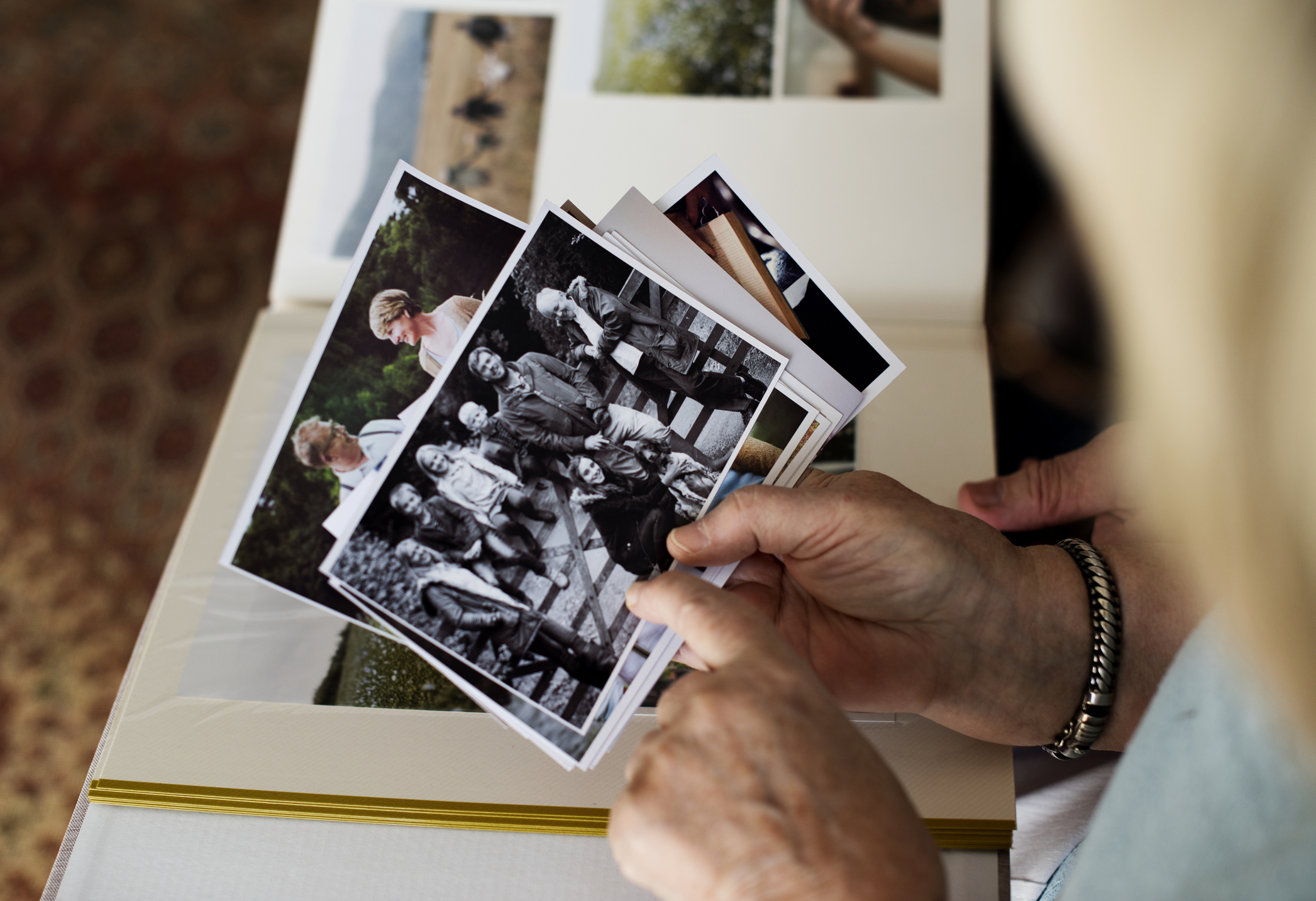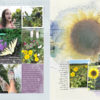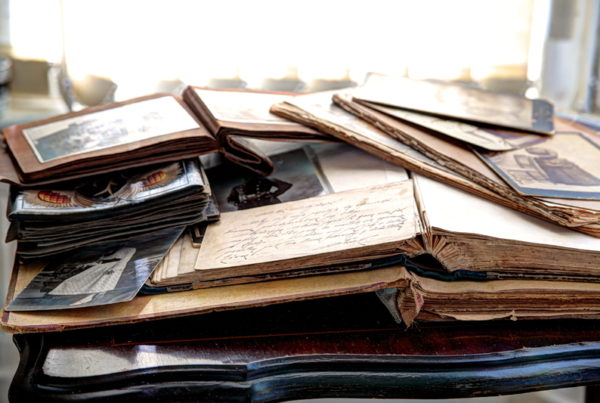Do you search through your digital files or are you a browser? When it comes to scrapbooking, I’m definitely a browser. In Family History Basics #10, I showed you how I use OneNote to keep a visual display of my digital supplies and templates. I love to see all my things laid out in front of me – paper or digital – so I can pick and choose exactly what I want to add to my layout. Well… I like to be able to see what is available to me when it comes to my family research as well.
As promised, this month we are going to take a look at one way to organize your family history documents and photos. If you are at the beginning of your journey to discover your family’s history, then I’d like to get you started on the right foot on storing all the “goodness” you have located.
Lesson learned the hard way
The goal is always to make the process as simple and easy as possible, but to get to that luxurious place where you can just type in a few words and voilà, your pics or documents will pop up, there is just no way around putting in a little bit of extra work on the front-end. I’m the kind of person that loves to have a system in place when I’m working on a project that requires repetition. And when it comes to family history research, there is a LOT of repetition as we SAVE the documents and then try to RETRIEVE them back when we need them. SO… let me explain one tried-and-true way that will endure time and will get you set for years to come.
Lessons Learned
Let me explain one crucial problem that I have experienced with naming systems and family history research. Of course I would be the first to acknowledge that I might be overthinking the process, but stick with me because there are some flaws to the more popular methods of naming and storing records and photos. When it comes to heritage photos or records that might include three generations of family members in it, how can I name a file to include all three family members? If I have folders for everyone, should I put it in the file for the oldest generation or duplicate it for all three people’s folders? Do I add everyone’s name that is in the photo or record into the filename? How will I find them if I don’t? I’ve tried all of those, believe me. And then you add in the fact that I’m not just dealing with photos, but PDF’s and Word documents as well, so this makes using a photo library organizer just not that helpful.
Let’s get Searching
I think that I might have stumbled upon the answer to my organization quandary that you might be able to use yourself. It’s working so well, that I just feel like it needs to be shared — so here we are! With just a bit of tweaking to the File Explorer/Search tools, I’m getting to that browsing experience I crave and you might find that it can help you as well in all sorts of ways!
Meta-who?
It all goes back to that Metadata that I’m guessing you have heard mentioned before, but stick with me, because once you get this done, I promise it will bring some true peace into your life. I’m not even overstating this because it feels amazing to finally have a solution that can work for all my needs.
Here’s the Basics
Once you are in File Explorer (on the PC), you can right-click on any file name and see the Properties option available in the pop-up menu. Once you have clicked Properties and you click on the Details tab you are now in the “golden” area of everything Metadata.
These “golden” areas include fields that are editable like the title, subject, tags, categories, comments and author’s fields as well as the date. Yes, I know it sounds a bit tedious, but it takes browsing to a whole new level. You can pretty much add as many tags as you would like so if you would like to search on a particular county or person or even event, it would take just a few keystrokes to bring up all the possible files that match your search terms.
Tags are Our Friends
You’ll just need a quick brainstorming session to decide on the types of tags that might be helpful down the road. Here’s a list of some general tag naming categories that I will think about for my own family:
- First names (of everyone in the photo)
- Surnames
- City
- State
- Year
- Event or Activity
- Special Item that brings a memory such as cars, toys, and animals (pets with or without their names)
- Period in life such as Child, Adult, Military, Family, Work, Retired, Organization
- Addresses
Not convinced that this will help? At first I was unsure as well, until I started to do some tagging and searching of my own. What it did was nothing short of amazing. First of all, I had to bring my File Explorer up. The left side of the screen is a tree view of how our computers are set up. Try clicking on a folder and then look at the Search box in the top right-hand side of the File Explorer window. It will tell you in gray that it is going to “Search My Pictures” or whatever folder you clicked on.
This means that you can pick where to do your Search in as broad or as narrow of terms as you would like. So, if I want to Search for a particular photo of my dad when he was a child, I would click on “My Genealogy” library so that it will only Search this folder and then enter, “Max child” into the Search box and up comes photos that I have tagged with “Max” and “child.” If I had just entered, “Max” into the Search box, then literally every photo with his name tagged in it would show up.
As I started to really get into my Tagging project, I ran into a tiny problem — literally. Some of the people in the photos were a bit too small to see very easily, even when I had changed my View to “Extra Large Icons.” So, how could I make the picture larger so I could see all the people that needed to be tagged?
That was fixed by looking at the options for my Panes, which I found at the top left section of the File Explorer window and choosing the Preview Pane. This really helps because when you are tagging people in a photo, it’s really nice to get everyone’s name entered.
Does the preview picture still seem small?
Now Maximize that Preview
One more step — and it gets really good at this point. Hover your cursor over the Scrolling ribbon that sits between the folder contents and your preview until you see a double-headed arrow. Click and drag your Preview Pane over to the left and wow… isn’t it really fantastic to be able to see that photo up close? Who knew you could adjust the size of the Preview Pane?
Now, you can right-click on your photo and dive into entering those tags onto your photos. With the Preview Pane nice and big, you can even take the size of the View Icons down to Medium or Large so that you can see more of your folder full of photos.
I received a gift of photos taken of my grandmother when she was young by a distant cousin and it would have made it so much easier to reciprocate with pictures of my grandmother’s sister back to her if I would have had my photos tagged. That way I could have simply searched on her name instead of having to poke around in all my folders to find what pictures I had of her to send off.
Group Tagging? Yes, Please…
Oh, I hear some of you groaning that this all has to be done individually, but guess what! I have one more surprise that makes this project even more enjoyable. You can tag photos in groups as well – yes, right within File Explorer. Who knew? Simply CTRL-click and highlight all the photos that will contain the same tag and you can then right-click, go to the Details tab in Properties and enter that group-wide tag. You’re welcome!
PDF tagging?
Mmmm… if you right-click on the PDF file and try to go to the Properties, you won’t see the golden Metadata area available, but there is a way to make it happen in there as well.
Mac Users have a handy-dandy tagging feature built into their file structure so you can simply right-click on a file name and locate the TAGS option where you can assign tags to all your files.
Window users have a bit more hoops to jump through, but it can be done AND is still worth the little bit of extra work on the front-end. If you have Adobe Acrobat Reader (It’s free and shown above), you can go into existing documents and add tags by clicking on FILE / PROPERTIES / and then adding keywords separated by commas or semi-colons into the KEYWORDS box (inside the Description Tab).
If you are in WORD (above picture) and want to save a document as a PDF with tags, then just do a SAVE AS and when the box pops up to add the file name, and look just below the naming area for the TAGS option. You can click inside the box and add the tags right there!
Browsing is the New Searching
Now I can enter my search terms and with everything right at the top of the list, I can pick and choose what I need or even see where I have holes in my research. And the beauty is that if I find that I need another tag added later, I don’t have to start over, I can just simply go back into the Properties and add it. It’s kind of like paper scrapbooking… I can see everything all at my fingertips to pick and choose which photos or story to add to my layouts. Oh, that gives me that serene “take me away Calgon” feeling that makes me no longer dread the organization process!
(Just a note: PNG’s cannot be tagged so adding the tag info into the filename would be helpful.)
And that my friends is a double-yay in my book.
Taking my time and really diving into a subject is a luxury I have given myself this time around as work on my grandparents’ generation. Instead of just looking for the documents that confirm the birth, marriage and death, I am actually researching the new terms that I am finding in newspaper articles and that is leading me to wonderful stories that really help to bring this time in my grandparents’ life to “life” for me.
Who knew that a dray was actually a type of hauler and that it started with the wagons that horses would draw and carried over to motorized vehicles. And a hack? Well, it has nothing to do with the term that we know today. It is a term used with the early school buses. They weren’t called buses at first, but were known as school hacks. Guess what kind of newspaper articles you would find if you searched for school buses in the 1920-30 time period? Almost nothing at all. But, plug in the word “Hack” and up pops all sorts of articles.
As a side note… The articles written about school buses back in the 1930’s seems eerily similar to today where the auto and truck drivers were not watching their speeds as they came upon school buses. The school bus drivers were worried that their children were going to be hit by speeding drivers. Hmmm…
And once again, I am still sticking with papers and elements from Anna Aspnes Designs. It is simple but looks so artistic and is filled with colors that help with the black and white images that I am using in the older photos!
As we are getting ready for the holidays, remember to bring out those old photos (especially the heritage photos) and be prepared to hear some great stories!















